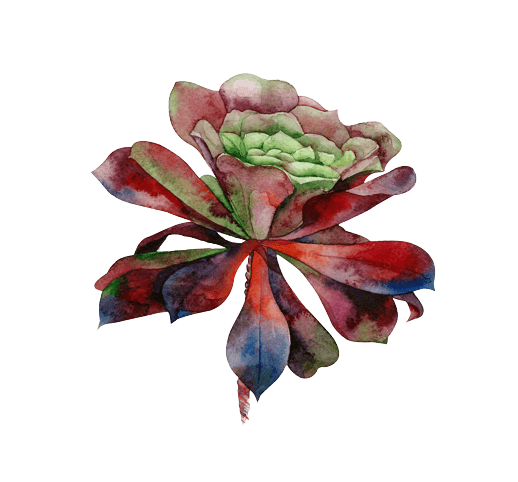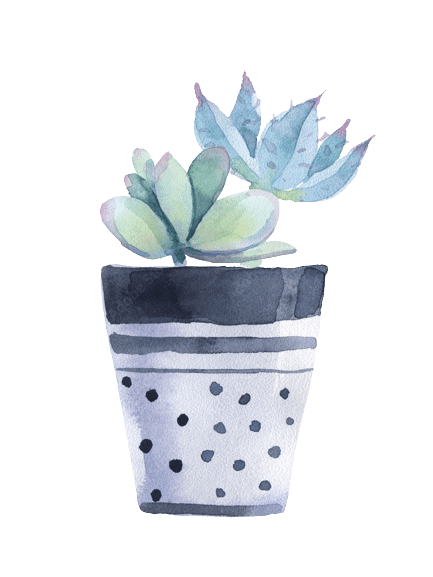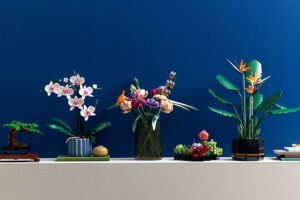Let’s delve into the captivating realm of popular succulent types, uncovering their distinctive characteristics and exploring the difference between succulents and cacti. Here are 20 of the most common types of succulents on the market today. This list is nowhere near exhaustive, and if you’d like to see a larger library of succulent types, check out our more comprehensive list of succulents here on the blog.
1. Echeveria: The Rosette Royalty
Let’s begin our exploration with the enchanting Echeveria, often referred to as the “Rosette Royalty” of the succulent world. Echeverias are renowned for their exquisite rosette formations, featuring plump and symmetrical leaves that come in a mesmerizing range of colors. From the delicate pastels of Echeveria ‘Lola’ to the vibrant purples of Echeveria ‘Perle von Nürnberg,’ these succulents effortlessly command attention. Their velvety and often powdery leaves add a tactile delight to their visual appeal, making them irresistible to touch. Echeverias are versatile, thriving in both indoor and outdoor settings, and they make stunning centerpieces in succulent arrangements or standalone potted displays.
2. Haworthia: The Architectural Marvels
Step into the world of Haworthia, where architectural elegance and intricate patterns take center stage. Haworthias are known for their compact growth habit and an incredible diversity of leaf shapes and textures. These succulents often have spiky leaves that form intricate geometrical patterns, making them true marvels of nature’s design. Haworthia cooperi and Haworthia fasciata are popular choices, displaying a symphony of green hues and delicate white lines that adorn their leaves. These architectural marvels thrive in bright, indirect light and are perfect for both indoor succulent gardens and outdoor rock gardens.
3. Sedum: The Trailblazing Beauties
Prepare to be captivated by the trailing allure of Sedums, which bring a sense of movement and cascading elegance to any succulent collection. These trailblazing beauties have a trailing growth habit, with stems that gracefully spill over the edges of containers or rock crevices. Sedum morganianum, commonly known as Burro’s Tail, features long, trailing stems adorned with plump, tear-shaped leaves that resemble strands of green beads. Another popular Sedum variety is Sedum rubrotinctum, affectionately known as Jelly Bean Plant, due to its chubby, jelly bean-shaped leaves that change color depending on light exposure. These trailblazing succulents add a whimsical touch to hanging baskets, living walls, or cascading arrangements, delighting both indoor and outdoor spaces.
4. Aloe: Nature’s Healing Gems
Aloes are not only renowned for their striking beauty but also for their remarkable healing properties. These succulents belong to the same family as Haworthia and share a similar growth habit. Aloes are characterized by their spiky leaves that form a rosette or clump, with some species producing showy, tubular flowers. Aloe vera, the most well-known variety, is treasured for its gel-filled leaves that have been used for centuries in traditional medicine and skincare. The gel is hailed for its soothing and moisturizing properties, making Aloe vera a popular natural remedy for sunburns and skin irritations. Beyond their healing attributes, Aloes add a touch of exotic charm to any succulent collection and thrive in sunny locations with well-draining soil.
5. Opuntia: The Majestic Cacti
While succulents and cacti share similar characteristics, it’s important to highlight the distinguishing features of the cactus family. Opuntia, commonly known as the Prickly Pear cactus, represents the majesty of the cacti world. These plants are characterized by their striking spines and paddle-shaped stems, creating a bold and sculptural presence. Opuntia species come in various sizes and colors, from the vibrant green Opuntia microdasys to the purple-toned Opuntia violacea. Beyond their aesthetic appeal, Opuntias produce showy flowers and, in some cases, edible fruits. These resilient and hardy plants thrive in arid regions and are excellent choices for xeriscaping or desert-themed gardens.

6. Crassula: The Sculptural Marvels
Prepare to be captivated by the unique and sculptural beauty of Crassulas. These succulents are known for their fleshy leaves and intriguing forms. Crassula ovata, commonly known as the Jade Plant, is a beloved succulent with thick, oval-shaped leaves that range from deep green to vibrant shades of red and yellow when exposed to sunlight. Another fascinating Crassula variety is Crassula perforata, also called the String of Buttons. This succulent features stacked leaves resembling a string of buttons, creating a visually striking display. Crassulas are highly adaptable and can thrive in various light conditions, making them versatile additions to any succulent collection.
7. Kalanchoe: The Blossoming Beauties
With their vibrant blooms and charismatic foliage, Kalanchoes are sure to steal the spotlight. These succulents produce clusters of colorful flowers that range from bright pinks and oranges to rich reds and yellows. Kalanchoe blossfeldiana, commonly known as Flaming Katy, is a popular choice with its dense clusters of long-lasting flowers. Kalanchoe tomentosa, or Panda Plant, showcases soft, fuzzy leaves adorned with reddish-brown spots, creating a delightful texture. These blooming beauties thrive in well-draining soil and prefer bright, indirect light, making them perfect for bringing bursts of color into indoor spaces or adding vibrancy to outdoor gardens.
8. Sempervivum: The Hens and Chicks
Step into the whimsical world of Sempervivums, commonly known as Hens and Chicks or Houseleeks. These succulents form tight rosettes with numerous offsets, creating a captivating pattern reminiscent of a mother hen surrounded by her chicks. Sempervivums come in various sizes and colors, ranging from soft greens and silvers to deep reds and purples. These hardy succulents are drought-tolerant and can withstand harsh weather conditions, making them ideal for rock gardens, living walls, or as groundcover in dry areas. Their charming rosettes provide an enchanting visual display that adds character to any garden space.
9. Agave: The Architectural Giants
Get ready to be amazed by the architectural grandeur of Agaves. These succulents are known for their dramatic and robust growth habits, making them the focal point of any landscape. Agave americana, also known as Century Plant, boasts large, symmetrical rosettes with spiky, serrated leaves that can reach impressive sizes. Agaves come in a variety of shapes and colors, from the striking Agave parryi with its compact and symmetrical form to the Agave victoriae-reginae, which showcases intricate white markings on its dark green leaves. These architectural giants thrive in sunny and arid conditions and are perfect for creating a statement in desert-themed gardens or adding a touch of boldness to large containers.
10. Aeonium: The Rosettes of Variety
Aeoniums are succulents that captivate with their stunning rosette formations and a wide range of colors and leaf shapes. Aeonium arboreum, also called Tree Aeonium, features rosettes of green leaves that can turn deep purple or black when exposed to direct sunlight. Aeonium kiwi displays variegated leaves in shades of green, yellow, and pink, creating a vibrant and eye-catching display. These succulents are known for their ability to change color based on light exposure, adding an element of intrigue to any collection. Aeoniums thrive in mild climates and require bright, indirect light to maintain their vibrant colors and compact growth.

11. Senecio: The Dainty Trailing Wonders
Senecios are a diverse group of succulents that offer delicate and cascading foliage, bringing a touch of elegance to any setting. Senecio rowleyanus, commonly known as String of Pearls, features trailing stems adorned with small, spherical leaves that resemble a string of glossy pearls. Senecio radicans, or String of Bananas, showcases elongated, banana-shaped leaves that dangle gracefully from the stems. These trailing wonders are perfect for hanging baskets, elevated shelves, or trailing down from containers, creating a visual spectacle that evokes a sense of serenity and beauty.
12. Crassula capitella: The Campfire Plant
Crassula capitella, also known as the Campfire Plant or Red Pagoda, is a captivating succulent that adds a fiery touch to any arrangement. This Crassula variety forms densely packed rosettes with leaves that transition from green at the base to vivid red or orange at the tips. The striking coloration resembles a blazing campfire, hence its popular name. Crassula capitella thrives in bright light and is drought-tolerant, making it a resilient choice for outdoor gardens or succulent arrangements that need a vibrant focal point.
13. Euphorbia tirucalli: The Firesticks
Euphorbia tirucalli, commonly known as Firesticks or Pencil Cactus, is a succulent that stands out with its unique appearance and vibrant colors. This succulent features pencil-thin stems that range from green to bright orange or red, creating a visually striking display. Although resembling a cactus, Euphorbia tirucalli is technically not a true cactus but rather a succulent with cactus-like characteristics. It thrives in full sun and can tolerate drought conditions, making it an excellent choice for xeriscaping or adding a splash of color to rock gardens.
14. Graptopetalum paraguayense: The Ghost Plant
Graptopetalum paraguayense, commonly known as the Ghost Plant or Mother of Pearl, is a mesmerizing succulent with pastel-hued leaves that give it an ethereal appearance. This succulent forms rosettes with overlapping leaves in shades of soft blue-gray or pale pink. When exposed to bright light, the edges of the leaves take on beautiful shades of pink or red, adding to its enchanting allure. The Ghost Plant is drought-tolerant and thrives in well-draining soil, making it a delightful addition to succulent arrangements or as a groundcover in outdoor gardens.
15. Lithops: The Living Stones
Prepare to be astonished by the peculiar charm of Lithops, aptly named the Living Stones. These succulents are renowned for their mimicry of stones and pebbles, allowing them to blend seamlessly into their natural surroundings. Lithops feature pairs of thick, fused leaves that resemble small stones, helping them camouflage and evade predators. These remarkable plants have a unique growth pattern, with new leaves emerging from the center and the older leaves drying up and disappearing. Lithops require minimal water and thrive in well-draining soil, making them an intriguing addition to rock gardens or as focal points in succulent arrangements.

16. Gasteria: The Hardy Houseplants
Gasterias are robust and hardy succulents that make excellent houseplants due to their adaptability and tolerance of lower light conditions. These plants are known for their thick, succulent leaves arranged in rosettes, featuring intricate patterns of raised lines or spots. Gasteria species come in various shades of green and sometimes display reddish or bronze tones. Gasteria maculata, or Ox Tongue, showcases elongated leaves with attractive white speckles, adding to its aesthetic appeal. These hardy houseplants thrive in bright, indirect light and can withstand periods of drought, making them perfect companions for indoor succulent gardens or as desktop adornments.
17. Dudleya: The Coastal Beauties
Dudleya is a genus of succulents that flourishes in coastal regions, adding a touch of natural beauty to seaside landscapes. These plants exhibit rosettes with fleshy leaves in shades of green, blue, or gray, often adorned with powdery or waxy coatings that protect them from harsh sun and salt spray. Dudleya brittonii, or “Giant Chalk Dudleya,” boasts large rosettes with chalky white leaves, creating a stunning contrast against the coastal backdrop. Dudleya species require well-draining soil and thrive in areas with cool temperatures and oceanic influence, making them ideal for gardens near the coast or as container specimens in sunny balconies.
18. Pachyphytum: The Jelly Bean Succulents
Pachyphytums are succulents that charm with their chubby, rounded leaves, resembling colorful jelly beans. These plants form compact rosettes and come in a variety of colors, including green, blue-gray, pink, and purple. Pachyphytum oviferum, also known as Moonstones, showcases plump, rounded leaves with a powdery coating that enhances their visual appeal. Pachyphytums are easy to care for and thrive in bright, indirect light. They are ideal for succulent arrangements or as standalone potted plants, adding a delightful and whimsical touch to any space.
19. Stapelia: The Star-Shaped Marvels
Stapelia is a genus of succulents that astonishes with its unusual and star-shaped flowers. These plants feature fleshy stems adorned with hairy or warty textures, and their striking flowers often emit a scent that attracts pollinators, particularly flies. Stapelia gigantea, commonly known as Carrion Flower, produces large star-shaped flowers with maroon or purple hues and a distinct odor resembling decaying flesh. Stapelia grandiflora displays intricate, star-shaped flowers in shades of yellow or red, creating a visually captivating display. Stapelias thrive in bright light and are often cultivated in succulent gardens or as conversation-starting additions to botanical collections.
20. Aeonium tabuliforme: The Dinner Plate Aeonium
Aeonium tabuliforme, also referred to as the Dinner Plate Aeonium, is a succulent that showcases a distinctive, flattened rosette form. Its leaves resemble the shape of a dinner plate, hence its popular name. This Aeonium variety features dense clusters of overlapping leaves in shades of green, often with striking patterns or edges in red or purple. Aeonium tabuliforme thrives in bright, indirect light and is an excellent choice for succulent arrangements or as an eye-catching centerpiece in outdoor gardens.
Each succulent type brings its own unique characteristics that showcase the wonders of nature’s creativity.



